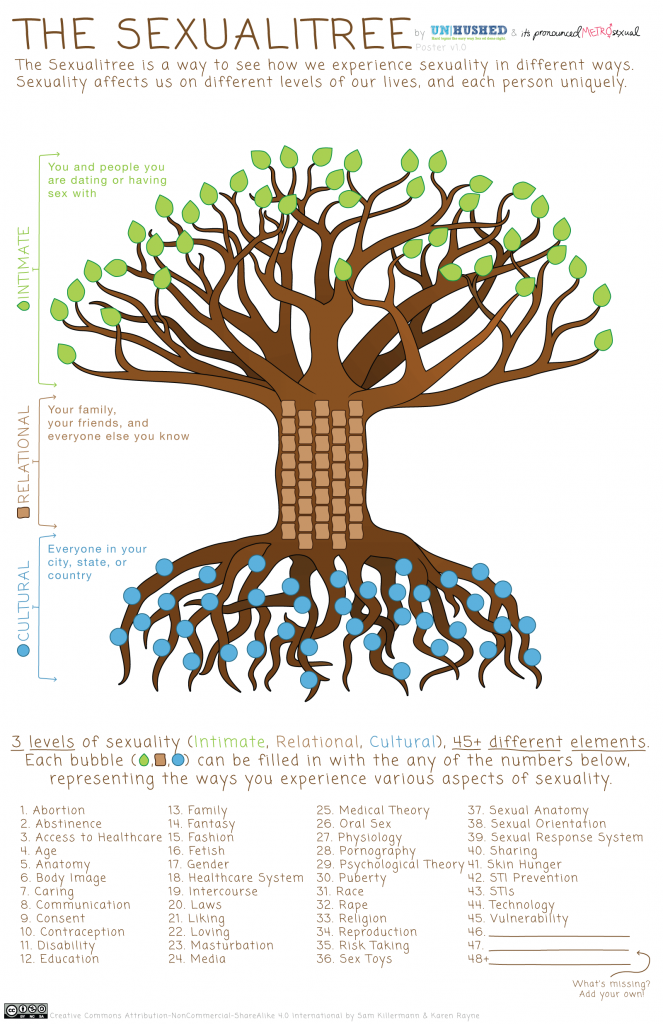What Is The Sexualitree?
Learn all about the sexualitree being used to teach students about sex education in an unusual, controversial way.

Schools have been using fun cartoonish images to make learning fun for years. As sexual education has gotten away from concepts like teaching the functions of reproductive organs, lessons have veered toward the topic of sexuality. This is now so common that cute propaganic images are being used to teach complex concepts in a way that makes them seem fun and approachable instead of allowing students time to reach proper maturity levels for mature content. From the Gingerbread Person infographic to the Gender Unicorn, sexuality is being explored as if it were some kind of choice that children need to make as soon as possible. Much like the sexualitree.
What Is The Sexualitree?
The Sexualitreeis yet another childish image of mature content designed to make learning about sexuality seem fun and cute. It is listed by its creators as, “a comprehensive model to see how we experience sexuality in different ways.” This info graphic uses the traditional layout of the Family Tree and contorts it into a network of roots, trunk panels, and leaves that are all tied into not just sexuality but also the many people that represent romantic ties and sexual partners.
It lists over 45 ways that everyone can explore sexuality, naming abortion as the #1 experience. Family is listed as #13. Pornography, race, and religion are all listed before sexuality is linked to reproduction, which is #34 on the long list. The Sexualitree looks to teach children that sexuality takes over every facet of life. This includes the media and technology.

What Are The Parts Of The Sexualitree?
There are three sections of The Sexualitree. It starts at the roots. These are drawn to represent cultural sexuality. It is defined by everyone in a person’s city, state, or country and tied to the 45+ examples of how sexuality is explored within society.
The trunk of The Sexualitree is drawn to include various panels. These are made to represent each student’s family, friends, and everyone else they know. It moves the family down beneath the branches — this is a curious move being that the family tree places the focus on the branches as the most important element of the structure.
Instead of the branches of the tree displaying the symbology of strength in branching out and starting a family, The Sexualitree’s third section is focused on the leaves — those disposable parts of the tree that fall off and are replaced every year. These represent a student’s intimate relationships, with an emphasis on the many people they will date and have sex with. The use of the leaves offers a subconscious teaching that it’s perfectly normal to sleep around and then discard partners when changes occur.
Where Is It Used?
It is unclear how many schools and educators plan to use The Sexualitree this fall, but it currently has over 43,000 downloads across 88 different countries and has been translated into three languages. The target age for this content is not listed, but the website devoted to this content notes that it’s for everyone. That would mean even young children from preschool and up. Educators are encouraged to use it in every way possible and free downloads are listed all over the website.
Who Created The Sexualitree?
The creators of the Sexualitree include Sam Killermann and Dr. Karen Rayne. Killerman also created The Gingerbread Person. He considers himself a comedian, activist, and author who wrote a social justice warrior handbook and delivered a TED talk about sexuality.
Rayne is a sexuality educator. She considers herself a curriculum writer, and is the author of three books exploring the topic of sexuality. Her Ph.D. is in educational psychology, and like Killermann, she herself, has no children.

Whether The Sexualitree was designed to engage high school teenagers or kindergartners is unclear, but the creators are enthusiastic about promoting this infographic and offering it for free to educators. Like many young teachers, they are committed to activism and instructing children to become allies in the LGBTQ+ movement. They’re working to simplify complex concepts in a way that makes casual sex seem healthy and normal at any age.
This material is likely to be utilized by progressive teachers in public schools. As The Biden Administration pushes for more “equity” and “diversity” even school grants are being based on how districts implement these kinds of lessons into curriculums. Teaching materials like The Sexualitree are growing more common and being considered by state and local education boards.



